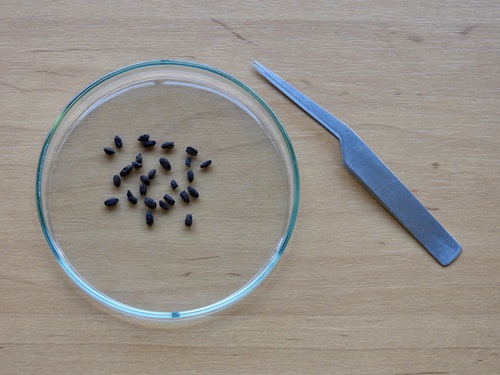The target crops: emmer wheat, rye and peas

Photo: Jess Beck
The three crops have been chosen because they were grown more extensively in ancient Ireland than nowadays. There are very few farmers growing emmer wheat in modern Ireland - for an exception, have a look at the work being undertaken by our collaborator at (opens in a new window)Cornstown House.
Emmer wheat is a relation of modern bread wheat but has different physical properties and ecological requirements. Emmer wheat is a hulled wheat, which means that its grains are tightly enclosed by chaff elements (glumes). Unlike bread wheat, threshing does not release the grains from the glumes. This means that the output of threshing is spikelets rather than naked grains, and an extra stage of processing is required to release the grains. But when stored as spikelets, these glumes act as a protective barrier against water and insect damage. Emmer wheat was grown successfully in low-input farming systems for several millennia, which makes it an attractive candidate for revival.
Rye is a relatively hardy and resilient crop, and it is starting to make a comeback in Ireland. Rye is interesting because it has the potential to be a multi-functional crop, providing an ingredient for the food-processing industry, and also for brewing and distilling industries seeking new and unique flavours. In previous centuries, rye was grown on a much larger scale – historical records from around 700 years ago indicate that rye was grown for export, as well as domestic consumption. Reviving crops like rye can help diversify our farming systems and broaden genetic diversity, thereby strengthening the agri-food sector in Ireland.
Peas were grown in many parts of Ireland in the past, even being produced on a scale that enabled their export. Modern production is centred on a small number of counties, however. This is despite the fact that peas are nutrient-dense and can provide an important protein source in human diets, as well as animal feed. Peas are also important as natural nitrogen-fixers in soils, and their cultivation can result in decreased agricultural inputs and higher-quality soils. But large-scale pea production can be challenging, especially in wetter conditions. Teagasc and other organisations are exploring ways to overcome these challenges, including growing companion crops alongside peas, which is a practice with a long history.
CROPREVIVE’s creation of a deep-time database on these underutilised traditional and locally adapted crops can inform national strategies aimed at withstanding climatic and environmental pressures and contribute to more sustainable forms of agriculture in Ireland.
The project is funded by the Irish Research Council COALESCE Scheme (2022–2024; Strand 2A; Project ID: COALESCE/2022/1647).
